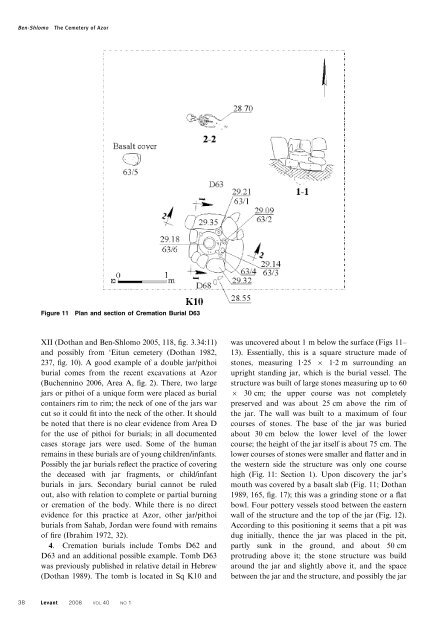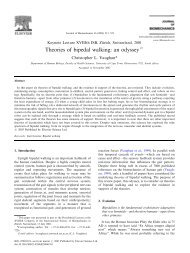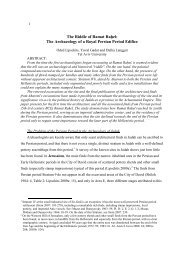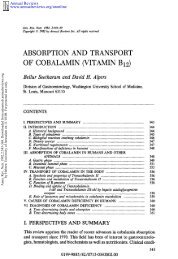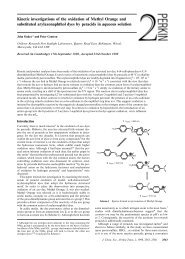The Cemetery of Azor and Early Iron Age Burial Practices
The Cemetery of Azor and Early Iron Age Burial Practices
The Cemetery of Azor and Early Iron Age Burial Practices
You also want an ePaper? Increase the reach of your titles
YUMPU automatically turns print PDFs into web optimized ePapers that Google loves.
Ben-Shlomo<strong>The</strong> <strong>Cemetery</strong> <strong>of</strong> <strong>Azor</strong>Figure 11Plan <strong>and</strong> section <strong>of</strong> Cremation <strong>Burial</strong> D63XII (Dothan <strong>and</strong> Ben-Shlomo 2005, 118, fig. 3.34:11)<strong>and</strong> possibly from ‘Eitun cemetery (Dothan 1982,237, fig. 10). A good example <strong>of</strong> a double jar/pithoiburial comes from the recent excavations at <strong>Azor</strong>(Buchennino 2006, Area A, fig. 2). <strong>The</strong>re, two largejars or pithoi <strong>of</strong> a unique form were placed as burialcontainers rim to rim; the neck <strong>of</strong> one <strong>of</strong> the jars warcut so it could fit into the neck <strong>of</strong> the other. It shouldbe noted that there is no clear evidence from Area Dfor the use <strong>of</strong> pithoi for burials; in all documentedcases storage jars were used. Some <strong>of</strong> the humanremains in these burials are <strong>of</strong> young children/infants.Possibly the jar burials reflect the practice <strong>of</strong> coveringthe deceased with jar fragments, or child/infantburials in jars. Secondary burial cannot be ruledout, also with relation to complete or partial burningor cremation <strong>of</strong> the body. While there is no directevidence for this practice at <strong>Azor</strong>, other jar/pithoiburials from Sahab, Jordan were found with remains<strong>of</strong> fire (Ibrahim 1972, 32).4. Cremation burials include Tombs D62 <strong>and</strong>D63 <strong>and</strong> an additional possible example. Tomb D63was previously published in relative detail in Hebrew(Dothan 1989). <strong>The</strong> tomb is located in Sq K10 <strong>and</strong>was uncovered about 1 m below the surface (Figs 11–13). Essentially, this is a square structure made <strong>of</strong>stones, measuring 1 . 25 6 1 . 2 m surrounding anupright st<strong>and</strong>ing jar, which is the burial vessel. <strong>The</strong>structure was built <strong>of</strong> large stones measuring up to 606 30 cm; the upper course was not completelypreserved <strong>and</strong> was about 25 cm above the rim <strong>of</strong>the jar. <strong>The</strong> wall was built to a maximum <strong>of</strong> fourcourses <strong>of</strong> stones. <strong>The</strong> base <strong>of</strong> the jar was buriedabout 30 cm below the lower level <strong>of</strong> the lowercourse; the height <strong>of</strong> the jar itself is about 75 cm. <strong>The</strong>lower courses <strong>of</strong> stones were smaller <strong>and</strong> flatter <strong>and</strong> inthe western side the structure was only one coursehigh (Fig. 11: Section 1). Upon discovery the jar’smouth was covered by a basalt slab (Fig. 11; Dothan1989, 165, fig. 17); this was a grinding stone or a flatbowl. Four pottery vessels stood between the easternwall <strong>of</strong> the structure <strong>and</strong> the top <strong>of</strong> the jar (Fig. 12).According to this positioning it seems that a pit wasdug initially, thence the jar was placed in the pit,partly sunk in the ground, <strong>and</strong> about 50 cmprotruding above it; the stone structure was buildaround the jar <strong>and</strong> slightly above it, <strong>and</strong> the spacebetween the jar <strong>and</strong> the structure, <strong>and</strong> possibly the jar38 Levant 2008 VOL 40 NO 1


